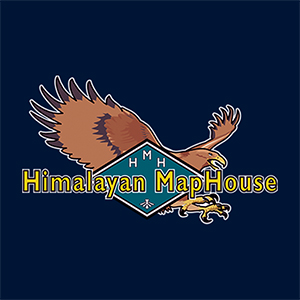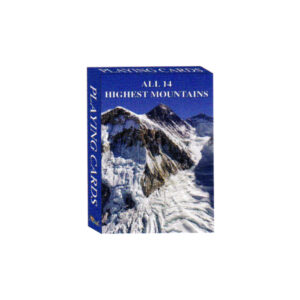No products in the cart.
NOTE: For delivery outside Nepal, please select any address. Then leave an order note and email address when confirming your order. We will contact you for details.
Series: City Map 300 Series
Scale: 1:15,000
Item No: CT302
Features
Comprehensive Touring Map
With enlargements:
- Kathmandu, Patan & Bhaktapur – 1:15,000
- Bhaktapur City – 1:4,000
- Bouddhanath – 1:8,500
- Thamel – 1:1,500
KATHMANDU/PATAN CITY HIGHLIGHTS
Kathmandu Durbar Square
Built between the 12th and 18th centuries, the Durbar Square is a complex of palaces, courtyards
and temples. It used to be the seat of the ancient Malla Kings of Kathmandu. An intriguing piece
here is the 17th century stone inscription set into the wall of the palace with writings in 15 languages.
Protected as a World Heritage Site, it is the social religious and urban focal point of the city. The
chief attractions are the Kashtamandap (a pagoda built from a single tree), the Kumari Chhe (house
of the Living Goddess), the Old Palace with three museums inside, and the numerous temples and
statues all around.
Patan Durbar Square
Like its counter part in Kathmandu, it is an enchanting living museum of palace buildings, artistic
courtyards and graceful pagoda temples. Listed as a World Heritage Site, the former royal palace
complex is the center of Patan’s religious and social life, and houses a museum containing an array
of bronze statues and religious objects. Most of the monuments in this square belong to the medieval
Malla period 15th to 17th century. One remarkable monument here is a 17th century temple dedicated
to the Hindu god Krishna, built entirely of stone. Kwa Bahal, a Buddhist monastery courtyard dating
back to the 12th century, Mahabouddha, Uku Bahal and Kumari Hiti – the bathing fountain of Malla
princesses – are other places of interest.
Bhaktapur Durbar Square
So exquisite is the art and architecture and the spatial layout of Bhaktapur that as you walk in, you
cannot but be overcome by a feeling of awe and admiration. The 15th century Palace, situated to the
left as you enter through the city gate, built in 1427 AD by King Yaksha Malla with 55 carved
windows and 99 courtyards, is the major attraction. While it also houses the National Art Gallery
inside, the entrance to the palace, the Golden Gate, is a masterpiece in the repose art. In front of the
palace building is a medley of temples and architectural structures of various designs. The must-visit
ones among them are Taumadhi Square to the east of Durbar Square, the towering five roofed
Nyatapol temple presiding over the Dattatreya Square, Peacock window and the Taleju temple.
Swayambhunath Stupa
Also known as Monkey temple, Swayambhunath watches over the Valley with its famous Buddha
Eyes from the top of a hillock 2 km west of Thamel. The huge stupa (10 m high and approx. 64 m
circumference) is one of the holiest Buddhists sites in the world and its origin is linked to the creation
of the Kathmandu Valley out of a primordial lake. It is listed as a World Heritage Site. The National
Museum and Museum of Natural History are situated at the foot of the hill.
Bouddhanath Stupa
lies about six Km to the east of downtown Kathmandu and is the largest stupa in the World. It looms
36 meters high and presents one of the most fascinating specimens of stupa design. Bouddhanath,
a World Heritage Site, is also known as Khasti, or dew drops, after an account that builders had to
use dew to mix the mortar as Kathmandu was suffering from a severe drought during its construction.
Pashupatinath Temple
One of the most sacred Hindu shrines in the world and also a World Heritage Site, Pashupatinath
lies 5 Km east of the city center. The richly ornamented pagoda houses the sacred linga, or phallic
symbol, of Lord Shiva. Chronicles indicate the temple’s existence prior to 400 AD. Devotees from
different parts of the Indian Subcontinent can be seen taking ritual dips in the holy Bagmati river
flowing beside the temple.
Gujeshwari
The Gujeshwari Temple, a Power Place in the valley, can be approached by a tail from the Pashupatinath
Temple or the downhill trail from Gorakhnath Temple.
Thamel
It is the main tourist hub, the multinational melting point of Kathmandu. Here you can find everything
from trekking paraphernalia to sophisticated mountaineering equipment, from economy lodgings to
the best bars, cafes and restaurants. It offers everything a tourist may need in Nepal.
Kirtipur
Kirtipur, a small historic town, 8km southwest of Kathmandu, lying atop a hill, was in fact a hill-
top fortress. It has many things to offer like old shrines and temples and old houses. The inhabitants,
predominantly Jyapus – a traditionally farming community, are typically dressed in traditional
costumes, and can be spotted working on looms and in paddy fields.
Balaju Water Garden
This former pleasure garden of the Malla queens-located at 2 km north-west of Thamel and on the
route to Kakani-is famous for its 22 stone taps and the exact replica of the Sleeping Vishnu.
Publisher’s Note
This map has been published by Himalayan MapHouse (P) Ltd., the only registered map publishing company in Nepal & a member of the International Map Trade Association (IMTA). Himalayan MapHouse produces the widest range of trekking maps in Nepal, updated to reflect the latest information regarding route changes and facilities available.
As an integral part of our Quality Assurance Program, we verify all information regarding trekking routes and trails with professional trekking guides & climbers and update our maps for accuracy and reliability. All altitudes are measured with analog & digital altimeters and the trekking times represent average times. Credit is due to the numerous trekkers who wrote/called/faxed/emailed, their suggestions for improvement.
Note: Discount on bulk orders. Contact us for details.
| Weight | 0.05 kg |
|---|---|
| Brands |
Based on 0 reviews
Only logged in customers who have purchased this product may leave a review.
Vendor Information
- Store Name: Himalayan MapHouse
- Vendor: Himalayan MapHouse
- No ratings found yet!














There are no reviews yet.